Bepotelkh are sapient cervids that come in a variety of shapes, sizes, colors, and attitudes. They are spirited creatures that follow their own whims and desires, seeking out places where they feel most content. For some, that is in the wild, either alone or with a herd, while others find that the comfort of a domestic life appeals to them more.
Table of Contents

Lifecycle
A bepotelkh fawn is at their most vulnerable during their first winter. While most survive, it is still dangerous for a young fawn, particularly those born late in the year. Of course, domestic bepotelkh fawns are much safer during their first winter than wild bepotelkh fawns.
Bepotelkh typically live to be 35 years of age, but domestic elkh have been known to reach the age of 50. Aitielkh live much longer than their non-magical brethren, although nobody is quite sure how old they can get.
When it comes to mates, partners, and other bonds of affection, elkh may:
- Choose a lifelong mate.
- Choose multiple lifelong mates.
- Choose to be solitary.
If an elkh wishes to have a fawn, they must make an offering to Aiti.

Biology
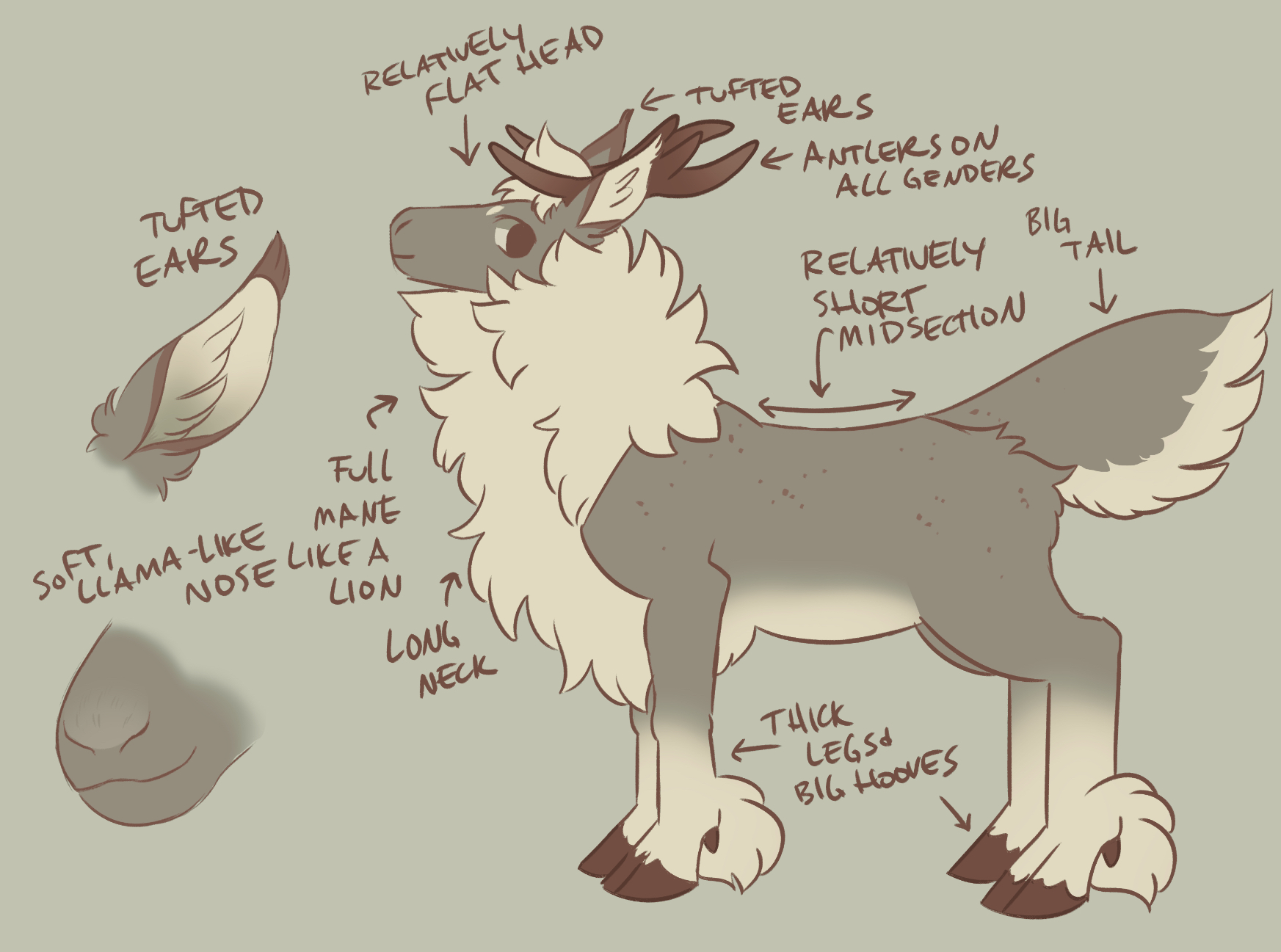
Beps have a few characteristics that set them apart from real world deer aside from their capacity for communication.
Height & Weight
Height and weight are heavily dependent on the subspecies of elkh. For example, a healthy taiga bepotelkh will weigh around 350 to 600 pounds, but villas will weigh considerably less and mountains considerably more!
Antlers
All elkh grow antlers that shed in early spring and immediately begin growing back. Like the antlers of other cervids, elkh antlers are covered in a layer of velvet that is shed when the antlers have finished growing. Unlike other cervids, elkh antlers grow remarkably fast; within about a month of antler shed, they will lose their velvet. Of course, elkh eat a considerable amount of food during this time.
While the number of antler points can be used to gauge the relative age of an elkh, it is not very precise. One can only assume that an adult elkh will have antlers with many points, but they do not necessarily continue growing more points each year. (Fun fact: you can change the number of tines on your elks antlers in any given drawing to show them at different ages, or for other reasons! You can also update their masterlist artwork with more or less antler tines.)
Antler size and shape are hereditary, but can also be affected by geographic location, diet, and potions crafted by witches. Generally, the more large and ornate the antlers, the more attractive the elkh is considered, but not all elkh buy into conventional beauty standards.
Teeth & Tusks
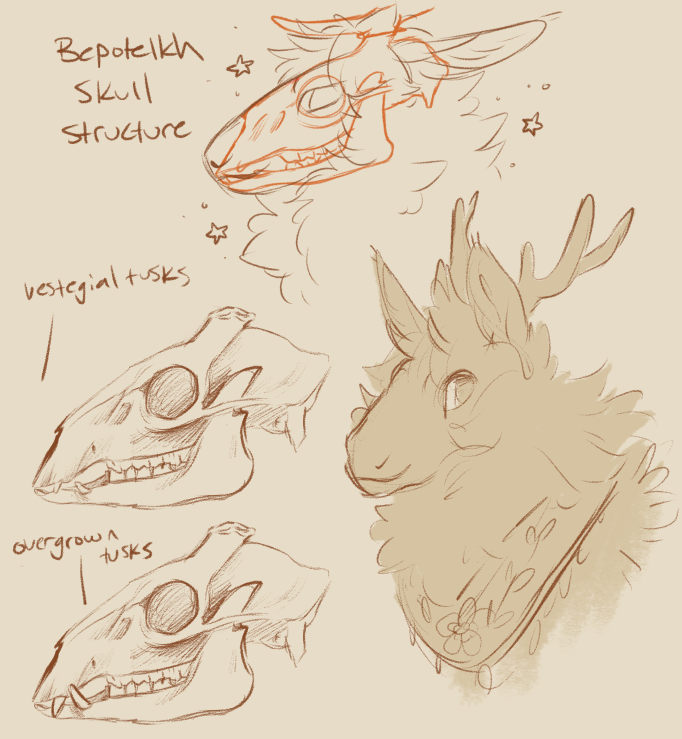
Elklh may possess small tusks on their upper or lower jaws—or both! Many do not possess these extra teeth, or they are so small as to not be visible when their mouth is closed. Visible tusks have become somewhat of a rarity.

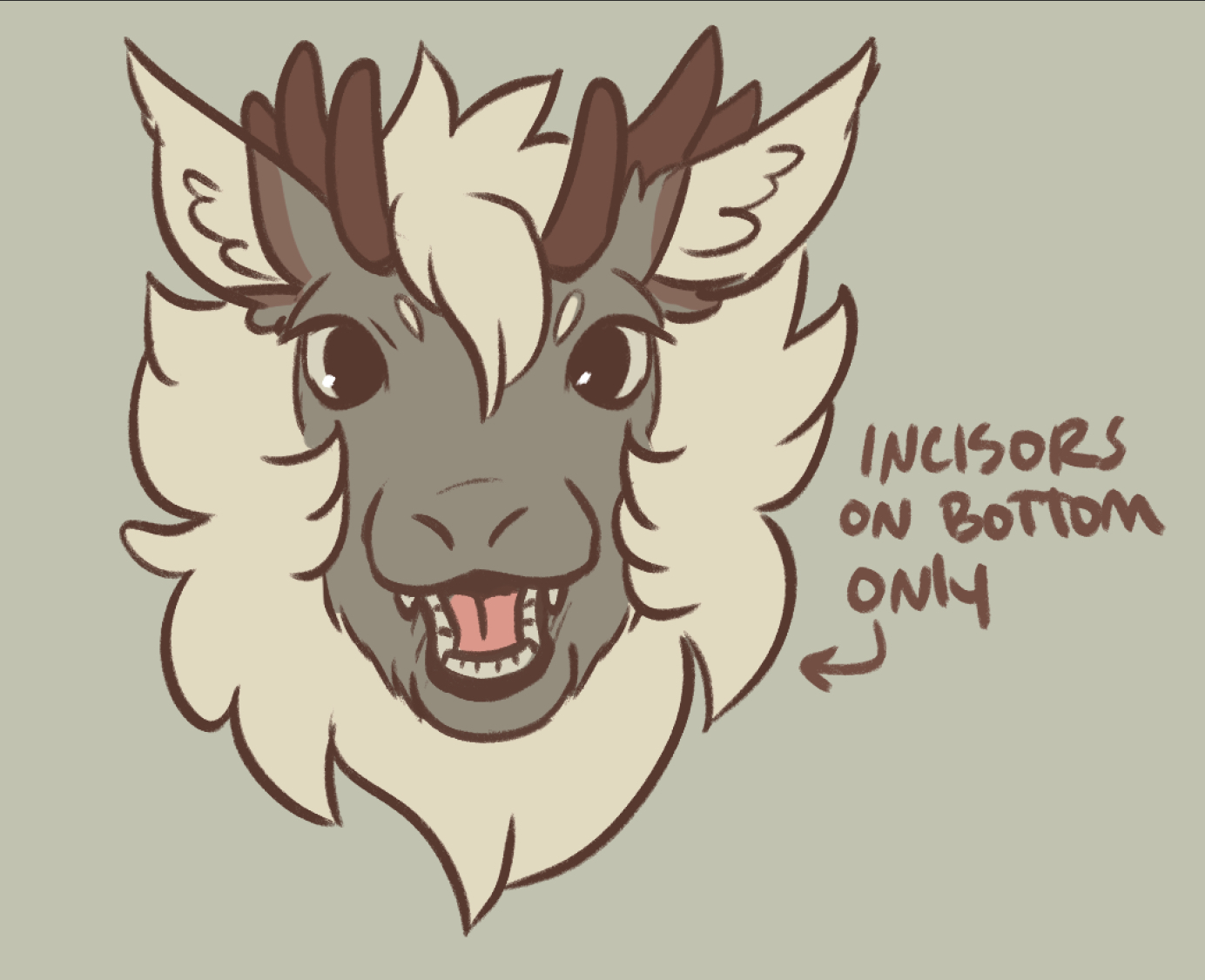
Aside from tusks, beps have typical cervine teeth and posess only a hard palate rather than top front incisors like a horse.
They do however have lower incisors!
The rest of their teeth are molars/premolars typical of cervids.
Coat
Bepotelkh have two distinct phases of pelage, growing a thick coat for the winter months that is shed in the spring for a thinner layer of fur. The mane remains, but may be slightly shorter in warmer months. Most elkh have thick manes; the fluffier they are, the more "conventionally" attractive they are to other elklh.
Fur color is determined by genetics as well as geographic location, but can generally be any color seen in most mammalian species.
Hooves
Like other cervids, elkh have cloven hooves as well as smaller dewhooves on the ankle. The underside of the hooves are padded, aiding in traction on snow, ice, and bare rock. They will typically have a fetlock tuft between the dewhooves, with the exception of sonoelkh and most swampland elkh. Bepotelkh and sonoelkh hooves are generally larger than most real-world deer hooves. All elkh share the same type of hooves, but there are two slight differences depending on subspecies: Highland elkh have slightly sharper hooves for climbing rocky mountains; Mountain elkh have very large and sharp hooves due to their size.
Diet
Bepotelkh are herbivores; in spring and summer, they feed on the soft foliage of plants, as well as berries and other fruits. They also eat mushrooms. In the fall, their diet is rich in acorns and wild fruits, but in winter they must resort to eating cedar, lichens, saplings, and, in emergency situations, tree bark. Of course, domestic elkh living among humans may continue to enjoy dried fruits, plants, and other, more flavorful foods throughout the winter. Wild elkh do sometimes hoard food for the colder months, but these stores do not always last.
The diet of domestic elkh may also be affected by factors such as class, income, and the culinary landscape of their home village. Some may enjoy mixed fruits, mushrooms, and grain with spices and herbs, or processed foods such as bread and other cooked foods. This is very dependent on the elkh in question, as some may dislike the complexity and fuss of preparing and eating such indulgences.

Society
Bepotelkh are fairly proud creatures. If the companion of a domesticated elkh does not treat them well, or fails to form a solid bond with them, they will not hesitate to leave to find a situation that suits them better. Some elkh are born and raised to the domestic life, but later return to the wild and their wild brethren if domesticity does not satisfy them. Wild elkh may choose to leave the wilderness and take up a more stable life among humans and other domesticated elkh. Other elkh may alternate between village life and the wilderness according to their needs and desires.
Just like humans, elkh will form relationships with other elkh that are both positive and negative, including friends, mentors, and romantic partners as well as rivals, antagonists, and even enemies. Some elkh enjoy the company of others and prefer to live among a herd, whether that herd is comprised solely of four-legged friends, two-legged friends, or both; others prefer the solitary life. Perceived class may also be important to elkh; for example, certain elkhs may believe that working class elkh are highly respectable, while another may believe that elkh who work for gildes are lesser than those who live wild and free. There is no general consensus on this, and many elkh are laid back enough to consider everyone equal regardless of class, but this discussion often results in a lot of head-tossing and snorting.
Bepotelkh generally do not tolerate being ridden, and most humans will not even ask. An elkh may allow a human companion with whom they have a very strong bond to ride them, but even then it is a rare concession unless they are a working elkh. For example, a medic's assistant may allow the medic to ride them to reach an emergency, or a hunting elkh may allow the hunter to ride as they track their quarry, but the individual elkh will decide if this is ncessary or desirable in every instance. Humans should never take the privelage for granted. Given the rarity of elkh-riding, saddles are uncommon, and most humans must ride bareback if riding is deemed necessary. At any great speed, it becomes necessary to hold on not to the bepotelkh's mane, but their antlers to remain seated, which can be risky for both rider and elkh.
Language
The term "bepotelkh" is a human word; when referring to their own species, bepotelkh simply refer to themselves as elkh. Elkh have their own language, but can learn to understand and speak human language. Like with humans, it is easier for a fawn to pick up human language than it is for an older elkh, but it is possible to learn as an adult. The mouths of elkh are shaped differently than those of humans, which means they have difficulty pronouncing certain sounds, particularly those that require the upper incisors.
Bepotelkh also use body language to communicate. Snorting, stomping, and head-tossing indicate an angry or irritated elkh; a frightened elkh will stand stiffly with their ears back and eyes wide. A happy elkh is relaxed, animated, and perhaps swishing their tail a little.
Most elkh speak to wild animals and companion animals at the same level of understanding as a human has with their domestic pet. The elkh can talk to the animal and depending on the relationship the animal has with the elkh, the animal may or may not understand them.
Some bepotelkh who have lived in the wild long enough get blessed by Aiti and gain the Wild Speak ability. This ability allows Beps to use a combination of speech, chattering and body language to successfully communitcate with all animals, wild or domestic.
Bells
Bells are often worn to alert predators in the area that an elkh is domestic and thus protected by humans. Over time, they have learned that if an elkh is wearing bells, a potential attacker runs the risk of retaliation in the form of human arrows and other weapons.
Bells vary in shape, size, and material, but they are typically long, conical, and made of copper. A large, single bell with a rectangular opening is used to alert humans that a working elkh is coming through, and is typically used for a medic's assistant. Bells may also be used in special events as decoration, but are usually muffled.
Spirituality
Goddess Aiti
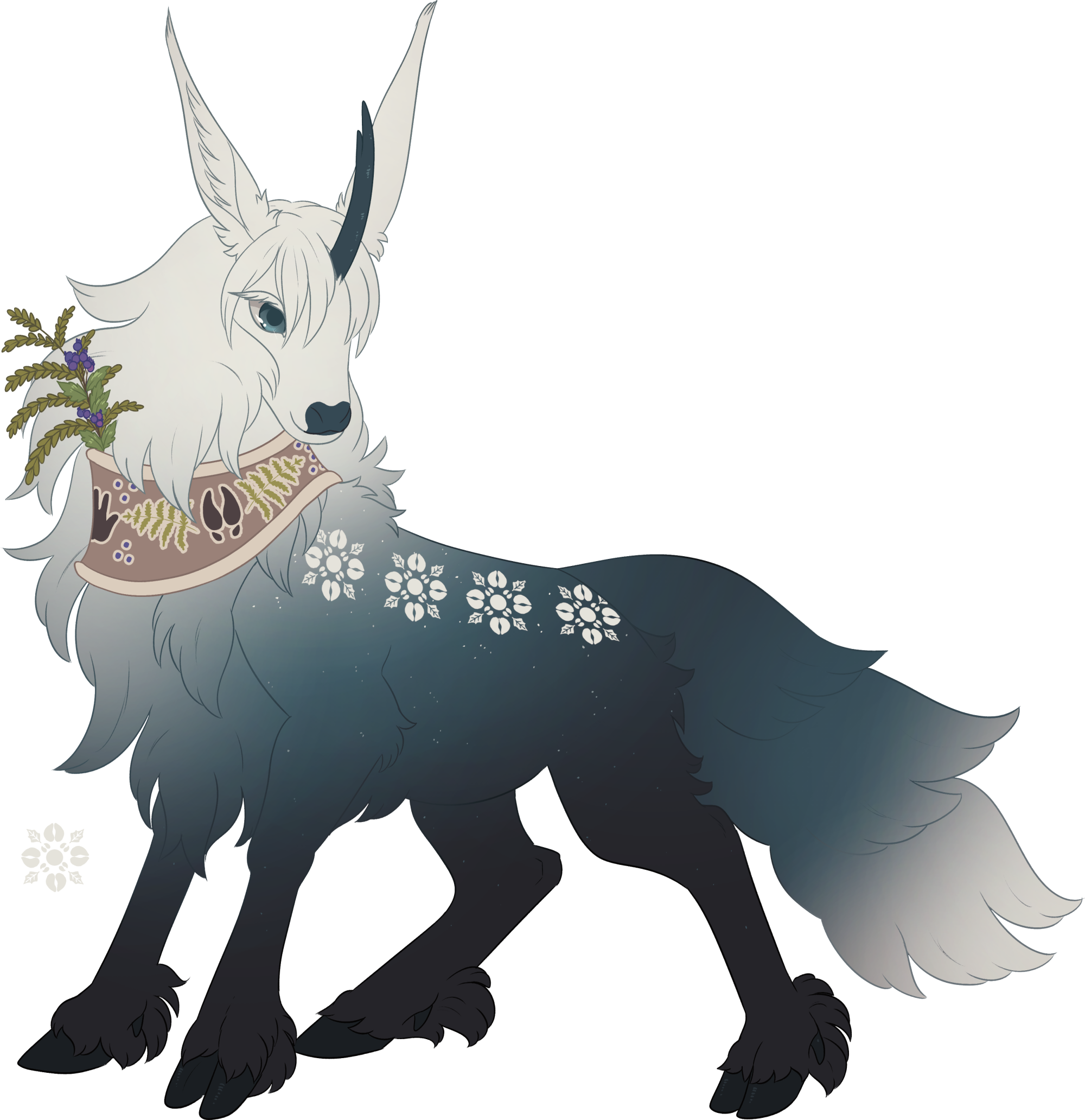
Aiti is the bepotelkh diety. The popular image of Aiti that resides in the minds of bepotelkh is of an elkh with white fur starting at her nose, fading to a dark bluish gray, becoming white again at her tailtip. She has a fluffy mane and glowing blue-gray eyes. Instead of a pair of antlers, she has a single antler growing forward from the middle of her forehead. She wears a manmade cloth necklace bearing images of fern fronds, elk prints, and human handprints. Tucked into either side of it are royal fern fronds and amelanchier branches. Her fur has a slight glitter to it and bears a repeating pattern of hoofprints and amelanchier leaves.
Aititongue
The summer solstice, the longest day of the year which falls between June 20th and 22nd, is said to be the day Aiti saved bepotelkh from extinction. They had been hunted to the brink by humans, when on that day, Aiti appeared in a clearing in the forest. A massive elkh with velvet antlers bearing 32 points appeared before a small group of village hunters. In the moment they were taken aback, Aiti layed down a shield fern frond and spoke the first words of any elkh.
"Do not kill the elkh."
The hunters were horrified. Hair standing on end, they quickly left the forest and returned to the village. When they returned the following day, a greater number of people appeared, bearing baskets of ripe solstice fruits like serviceberry and strawberry. Aiti fearlessly faced the people again, and found that they would not only respect her wishes, but welcomed the elkh into their lives with open arms as fellow sentient beings. Aiti served for many years as an ambassador for elkh, traveling between the village and the wild.
It is said that Aiti granted language to all elkh to save their lives. As time goes on, there are heated arguments about whether or not language developed naturally, and if Aiti was simply the first to learn to communicate with humans and develop a common tongue. No matter what the interpretation of this constantly shifting verbal history, all know that Aiti existed at some time and is the reason elkh survive and are treated with high respect by humans throughout the world.
The Solstice and the Shrine
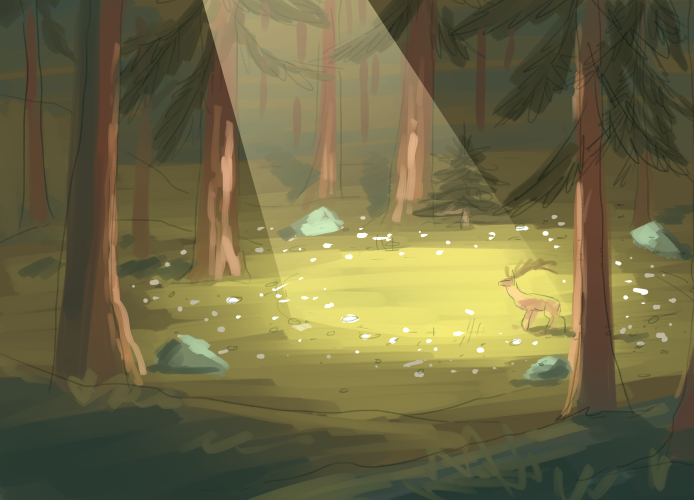
Each year, on the summer solstice (when their antlers are in velvet), elkh travel to find a shrine. Shrines exist throughout the world so elkh don't need to travel for more than 1-3 days to find a place to pay respects. In some locations, arrangements have been made with the local shroomkin to innoculate the area with certain species of mushroom the elkh prefer to eat. Both in return and as an offering to Aiti, elkh carry a single shed antler to the shrine each year. The antlers disappear after they leave, some taken by shroomkin to be made into tools, and others used by many other species of wildlife as a source of calcium, a way to wear down ever-growing rodent teeth, or a teething toy for young carnivores.
Elkhs may also bring branches bearing ripe serviceberry fruit and shield fern fronds to lay around the shrine clearing, forming a circle. The outside of the circle is always marked by four stones at the four directions. The interior of the circle is dug up by sharp elk hooves each year, turning the soil and preventing trees from growing and overtaking the sacred space. The elkh spend the night here, eating mushrooms, berries, and various solstice greens in the forest, sleeping in the circle and dreaming dreams as they quietly reflect on what Aiti did to give them their place in the world.
Both wild and "civilized" elkh meet at these events, which sometimes means wild elkh may go with civilized elkh to give domestic life a try for awhile, or vice-versa. Elkh who have clothing will most certainly wear it to the shrine, displaying their bond with humanity to Aiti. If they wear their work clothing, they may leave behind their tools and other burdens for the long journey. Sometimes, the work clothing may be repurposed to carry offerings to the shrine.
Differing Traditions
The story of Aiti is said to have happened at a very specific village (where most of the extant elkh in Badjer's universe currently live). This place has a very old relationship with elkh. But elkh live in a variety of places throughout the world. Certain rituals may be different in different places. For example, on the tundra, there may not be the usual forest cover for a shrine, but it is still marked with the four directional stones and the soil still turned each year to prevent growth. Shrines may also be built around certain landmarks, such as trees, stones, or certain water features. It's also possible that some subspecies of elkh have different ideas about what Aiti looked like- perhaps a little more like them.
Aitielkh do not use the shrines other bepotelkh use, as they devote their lives to Aiti to begin with, and hold their own rituals on a regular basis. These rituals are based on the seasons, the stars, and the moon phases and may involve antler and plant offerings, as well as songs and dance (which is more of a stepping march).
